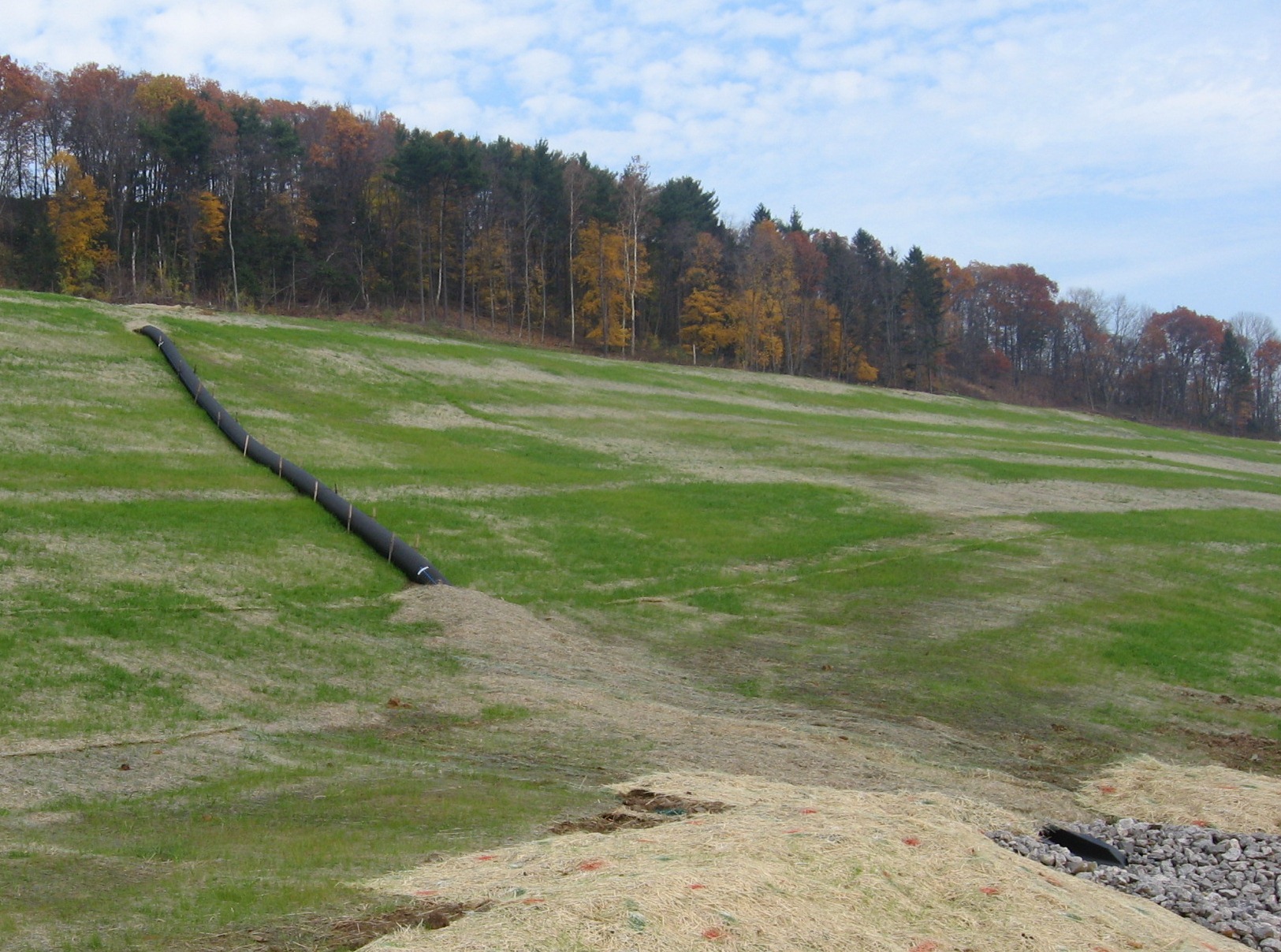Slope Drain, Temporary

Definition
A pipe extending from the top to the bottom of a cut or fill slope and discharging into a stabilized water course or a sediment trapping device or onto a stabilization area. Used to carry concentrated runoff down steep slopes without causing gullies, channel erosion, or saturation of slide-prone soils until permanent water disposal measures can be installed.
Where Practice Applies
This practice applies to construction areas where storm water runoff above a cut or fill will cause erosion if allowed to flow over the slope.
Advantages
Slope drains provide a potentially effective method of conveying water safely down steep slopes.
Disadvantages/Problems
Care must be taken to correctly site drains and not underdesign them. Also, when clearing takes place prior to installing these drains, care must be taken to revegetate the entire easement area, otherwise erosion tends to occur beneath the pipeline, resulting in gully formation.
Planning Considerations
- Temporary slope drains are generally used in conjunction with diversions to convey runoff down a slope until permanent water disposal measures can be installed.
- There is often a significant lag between the time a cut or fill slope is completed and the time a permanent drainage system can be installed. During this period, the slope is particularly vulnerable to erosion. This situation also occurs on slope construction which is temporarily delayed before final grade is reached.
- When used in conjunction with diversion dikes, temporary slope drains can be used to convey stormwater from the entire drainage area above a slope to the base of the slope without erosion.
- Slope drains must extend downslope to stable outlets, or special outlet protection must be provided.
- It is very important that these temporary structures be sized, installed, and maintained properly since their failure will often result in severe gully erosion. The entrance section must be securely entrenched, all connections must be watertight, and the conduit must be staked securely.
- Temporary slope drains should be replaced with more permanent structures as soon as construction activities permit.
Design Recommendations
Capacity
Sufficient to handle a 10-year peak flow. Permanent pipe slope drains should be sized for the 25-year peak flow.
Drainage Area
The maximum drainage area recommended per pipe is ten acres. For larger areas, a rock-lined channel or more than one pipe should be installed.
Material
Strong, flexible pipe such as heavy duty, non-perforated, corrugated plastic.
Pipe size
Based on drainage area:
| Maximum Drainage Area Per Pipe (Acres) | Minimum Pipe Diameter (Inches) |
| 0.50 | 12 |
| 0.75 | 15 |
| 1.00 | 18 |
| >1.00 | Individually designed |
Entrance
The entrance should consist of a standard flared-end section with a minimum 6-inch metal toe plate to prevent runoff from undercutting the pipe inlet. The slope of the entrance should be at least 3 percent. Connection to diversion ridge at top of slope: compacted fill over pipe with minimum dimensions 1.5-foot depth,4-foot top width, and 0.5 foot higher than diversion ridge. The soil around and under the pipe and entrance section should be thoroughly compacted to prevent undercutting. The flared inlet section shall be securely connected to the slope drain and have watertight connecting bands. Slope drain sections shall be securely fastened together and have gasketed watertight fittings, and be securely anchored into the soil.
Interceptor dikes
Interceptor dikes should be used as needed to direct runoff into a slope drain. The height of the dike should be at least 1 foot higher at all points than the top of the inlet pipe.
Outlet
The area below the outlet must be stabilized with a riprap apron. If the pipe slope drain is conveying sediment-laden water, direct all flows into the sediment trapping facility.
Common Trouble Points
- Washout along the pipe due to seepage and piping: Inadequate compaction, insufficient fill, or installation too close to edge of slope.
- Overtopping of diversion caused by undersized or blocked pipe: Drainage area may be too large.
- Overtopping of diversion caused by improper grade of channel and ridge: Maintain positive grade.
- Overtopping due to poor entrance conditions and trash build up at pipe inlet: Deepen and widen channel at pipe entrance; inspect and clear inlet frequently.
- Erosion at outlet: Pipe not extended to stable grade or outlet stabilization structure needed.
- Displacement or separation of pipe: Tie pipe down and secure joints.
- CAUTION!! Do not divert more water to the slope drain than it was designed to carry.
Maintenance
- Failure of a temporary slope drain can cause severe erosion damage. This practice requires intensive maintenance. Inspect slope drains and supporting diversions once a week and after every rainfall event.
- Check inlet for sediment or trash accumulation. Clear inlet and restore proper entrance condition. The inlet should be free of undercutting, and no water should be going around the point of entry. If there are problems, the headwall should be reinforced with compacted earth or sand bags.
- Check fill over pipe for settlement, cracking, or piping holes. Repair immediately.
- Check for seepage holes at point where pipe emerges from dike. Repair immediately.
- Check conduit for evidence of leaks or inadequate lateral support. Repair immediately.
- Check outlet for erosion or sedimentation. Clean, repair, or extend as needed.
- When slopes have been stabilized, inspected, and approved, remove temporary diversions and slope drains and stabilize all disturbed areas.
References
Massachusetts Department of Environmental Protection, Office of Watershed Management, Nonpoint Source Program, Massachusetts Nonpoint Source Management Manual, Boston, Massachusetts. June, 1993.
North Carolina Department of Environment, Health, and Natural Resources, Erosion and Sediment Control Field Manual , Raleigh, NC, February 1991.
Washington State Department of Ecology, Stormwater Management Manual for the Puget Sound Basin, Olympia,WA,February,1992.